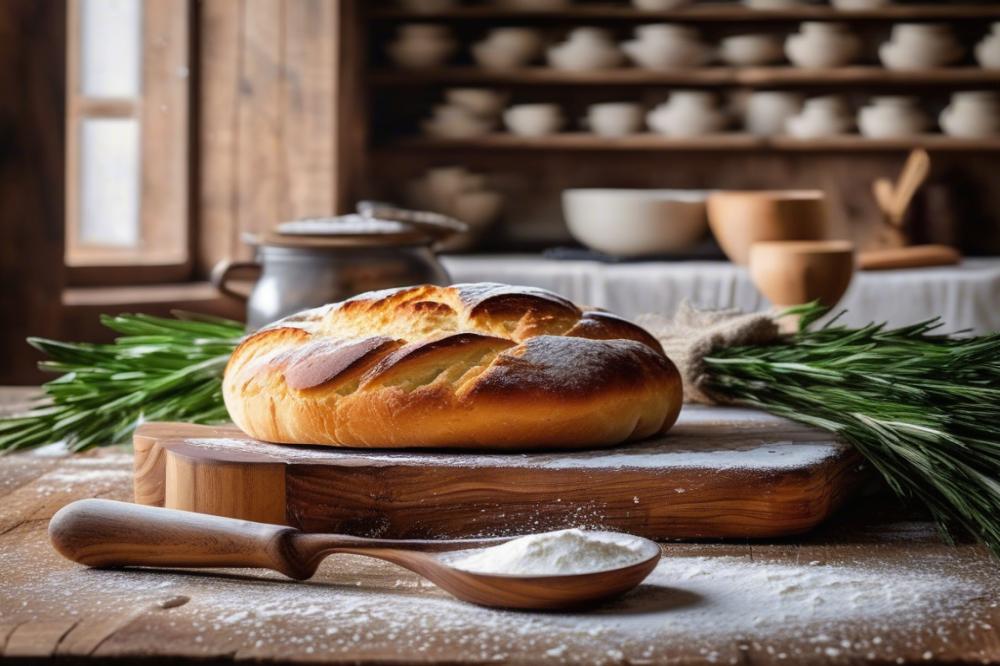Introduction
Crescia al Formaggio is a delightful Italian Cheese Bread that embodies the rich culinary tradition of Italy. This special bread finds its roots in Umbrian cuisine, a region known for its rustic and hearty flavors. Many families in this area cherish the recipe, which has been passed down through generations. Baked cheese bread has become a beloved item during festive occasions and everyday meals alike.
A closer look at Italian bread reveals a wide variety of regional specialties across the country. Each region has its own version, contributing to the diverse landscape of savory bread. In Umbrian cuisine, Crescia al Formaggio stands out for its unique combination of ingredients, mainly cheese and bread batter. Traditional Italian recipes highlight the significance of using local cheeses, which play a vital role in the final flavor.
When thinking about how to bake this delicious bread, understanding its history adds to the experience. Originating from a need to create satisfying meals with simple ingredients, this recipe illustrates how resourcefulness led to exceptional results. Soft bread paired with rich, melted cheese results in a product that is comforting and flavorful.
Throughout Italy, savory bread is enjoyed by many, making it an essential part of the food culture. Bread baking tips often include using high-quality ingredients and allowing the dough to rest properly. This care in preparation reflects the Italian dedication to food. By exploring Crescia al Formaggio, one engages with a piece of Italy’s heart and soul.
What is Crescia al Formaggio?

Crescia al Formaggio is a traditional Italian Cheese Bread that originates from the region of Umbria. Known for its rich flavors, this savory bread is typically made with a combination of flour, eggs, and cheese. It stands out for its soft texture and delightful aroma, making it a beloved part of Umbrian cuisine. Bakers often enjoy the process of creating this delicious treat, as it combines simple ingredients to yield impressive results.
This type of Italian bread is distinct compared to other loaf varieties found across the country. Its unique use of cheese not only enhances flavor but also contributes to its moistness. When you take a bite, the crust offers a slight crunch while the inside remains soft and cheesy. Many describe it as comfort food, perfect for any time of day.
Crescia al Formaggio plays an important role in regional specialties. It is often served during special occasions or family gatherings. Some people enjoy it as an appetizer, while others may have it alongside main courses. The combination of savory cheese and soft bread creates a delightful pairing that complements various meals. It can be enjoyed on its own, or with dips and spreads.
When it comes to making this baked cheese bread, using a cheese bread recipe is essential. Various cheeses can be utilized, from Parmigiano-Reggiano to pecorino, each bringing its unique flavor to the bread. Home bakers frequently share their bread baking tips, highlighting the importance of the right baking time and temperature. These details can make all the difference in achieving the perfect loaf.
Ingredients List and Cooking Instructions

To bake a delicious cheese bread recipe like Crescia al Formaggio, gather these ingredients:
- 500g all-purpose flour
- 250ml whole milk
- 3 large eggs
- 100g grated pecorino cheese
- 100g grated parmesan cheese
- 100ml olive oil
- 10g baking powder
- 5g salt
- Freshly cracked black pepper to taste
Now, let’s dive into the cooking instructions. Follow these steps to create this savory bread:
- Start by preheating the oven to 180°C (350°F). This prepares the environment for baking.
- In a mixing bowl, combine flour, baking powder, and salt. This forms the dry base of your dough.
- Take another bowl to whisk eggs, milk, and olive oil. Mixing these ingredients well is essential for smooth batter.
- Next, pour the wet mixture into the dry ingredients. Stir until you achieve a smooth consistency.
- Gently fold in grated pecorino and parmesan cheeses. This step enhances the cheese flavor in your baked cheese bread.
- Prepare a baking pan by greasing it slightly. This prevents the bread from sticking.
- Now, pour the batter into the pan, spreading it evenly. Ensure no air bubbles remain in the mix.
- Bake for about 40-50 minutes. The bread should turn golden, and a toothpick inserted should come out clean.
- After baking, let it cool for a few minutes. This allows for easier slicing before serving.
Each ingredient provides nutritional benefits. Here’s a breakdown:
- 500g all-purpose flour: 1800 calories, 56g protein, 4g fat, 380g carbs
- 250ml whole milk: 150 calories, 8g protein, 8g fat, 12g carbs
- 3 large eggs: 210 calories, 18g protein, 15g fat, 1g carbs
- 100g grated pecorino cheese: 400 calories, 25g protein, 33g fat, 1g carbs
- 100g grated parmesan cheese: 431 calories, 38g protein, 29g fat, 4g carbs
- 100ml olive oil: 884 calories, 0g protein, 100g fat, 0g carbs
- 10g baking powder: 5 calories, 0g protein, 0g fat, 1g carbs
- 5g salt: 0 calories, 0g protein, 0g fat, 0g carbs
- Black pepper: Negligible calories
Balancing macronutrients is key for a wholesome diet. Embrace these regional specialties from Umbrian cuisine to enjoy the diverse flavors of traditional Italian recipes. For bread baking tips, remember to always sift the flour for a lighter texture.
Tips for Baking Crescia al Formaggio

Baking Italian bread can be a delightful experience. When working with a cheese bread recipe, there are several tips that can enhance your final product. Keep in mind that the quality of your ingredients is crucial. Using high-quality cheese makes a significant difference in flavor.
A popular choice is Pecorino Romano or Parmigiano-Reggiano, which adds a sharpness to the savory bread. If you want to substitute, consider mixing different cheeses. Cheddar or Fontina can also work well, offering rich flavors.
Texture plays a big role in how the finished baked cheese bread feels. The dough should be soft but not overly sticky. Adjust the amount of flour based on humidity. Kneading the dough thoroughly promotes a better structure. Aim for a smooth and elastic texture when you’re done.
While baking, the oven temperature must be just right. A lower temperature can result in uneven cooking. Preheat the oven to about 375°F (190°C) for best results. Placing the bread in the center of the oven allows for even heat distribution.
If your bread doesn’t rise as expected, there may be an issue with the yeast. Always check the expiration date of your yeast before using it. If the bread is too dense, this usually indicates over-kneading or not enough air in the dough.
Don’t forget to let it cool before slicing. Cut into the bread too soon, and you risk losing moisture. This Italian cheese bread is best enjoyed fresh, but it can also be stored. Wrap it in a cloth to retain its softness.
Remember that the great world of Umbrian cuisine includes many regional specialties. Exploring different aspects of traditional Italian recipes can lead to delightful discoveries. Take notes on what you like best as you try your hand at this unique creation. Enjoy the process; each attempt teaches valuable lessons for future bakes.
Serving Suggestions and Pairings
Crescia al Formaggio is versatile and delicious. This Italian bread can be served in many ways. It makes an excellent snack or a delightful appetizer. For a simple serving suggestion, cut it into squares and offer it with a variety of cheeses and olives. This method highlights its rich flavor and soft texture.
Pairing it with wine can enhance the experience. A light white wine, like Pinot Grigio, complements the cheesy bread nicely. Alternatively, a fruity red, such as Chianti, can also work well. Both options bring out the flavors of the baked cheese bread.
Including soups or salads with your meal is another great idea. Tomato soup, in particular, pairs beautifully with this savory bread. The acidity of the soup contrasts with the richness of the cheese. A fresh arugula salad can also introduce a peppery flavor to balance the dish.
Using Crescia al Formaggio in sandwich recipes adds variety to your meals. Try adding some cured meats or roasted vegetables for a savory twist. The soft bread helps hold together all the ingredients, creating a satisfying bite. Creating a melted cheese sandwich with this bread is also an option.
Serving it as a side dish has its benefits. It complements many regional specialties from Umbrian cuisine. Consider offering it alongside grilled meats or hearty stews. The bread soaks up the juices and spices, enhancing the overall flavor.
When you learn how to bake this delicious cheese bread, you open doors to many culinary possibilities. Adapting it for different occasions is simple. With a little creativity, Crescia al Formaggio can become a star on your dining table. Enjoy experimenting with various pairings and serving styles!
The Joy of Baking Italian Crescia al Formaggio
Baking Italian Crescia al Formaggio at home brings incredible joy and satisfaction. The process unveils a world of flavors and aromas that fill the kitchen, inviting everyone to pause and appreciate what’s cooking. As the bread bakes, the rich scent of cheese tantalizes the senses, making it hard to resist. This simple yet satisfying cheese bread recipe allows for lots of creativity. Feel free to experiment with different cheeses or even add herbs for a personal touch.
Tradition holds a special place in Italian culture, especially when it comes to food. Families gather around the table to enjoy shared meals, highlighting the importance of togetherness. Homemade treats like this savory bread strengthen bonds and create lasting memories. Each loaf represents a connection to heritage, passed down through generations. Baking becomes not just a skill but a way to express love for one another.
Sharing baked goods with friends and family opens the door to conversations and laughter. Every slice offers a story and a chance to connect. As you bring this Italian bread to the table, take pride in your creation. Enjoy the flavors, relish the moments spent with loved ones, and continue the beautiful tradition of sharing comfort through food. Embrace the adventure of baking and let your kitchen become a hub of warmth and happiness.

